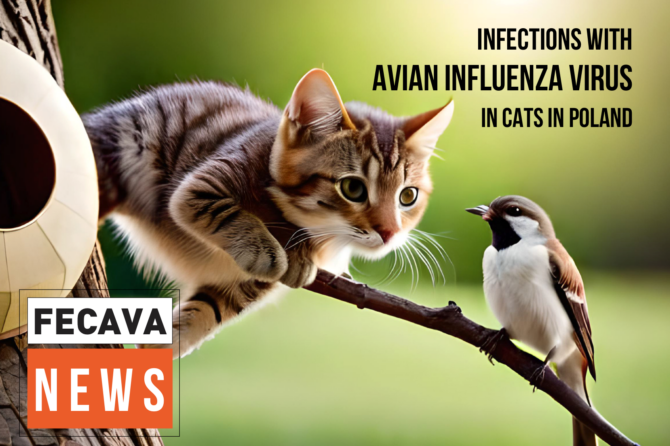
Infections with Avian Influenza A(H5N1) virus in cats in Poland
OFFLU, the Organization for Animal Influenza, is closely monitoring the situation in Poland following a series of unusual deaths in domestic cats reported across the country. Over the past week, these cases have garnered significant attention in the media.
Felidae, encompassing both wild and domestic cats, have been known to be susceptible to Influenza A(H5N1) viruses. Previous studies (Chen et al., 2016; Frymus et al., 2021) have indicated that most cases of infection in cats result from the ingestion of carcasses of wild birds carrying the virus.
On June 26, the Polish Chief Veterinary Officer released a report stating that out of 11 affected cats tested, nine were found to be infected with Influenza A(H5N1) virus. The severity and rapid progression of the infection align with previously documented cases in Felidae. Symptoms exhibited by infected cats can range from listlessness, loss of appetite, and severe depression to fever, neurological issues, respiratory and digestive signs, jaundice, and even death. Clinical signs typically appear within a few days of exposure to the virus. Fatal cases of Influenza A(H5N1) infection in cats have also been reported in Europe and North America during the current clade 2.3.4.4b panzootic, including a case in France where a cat experienced dyspnea and nervous symptoms (Briand et al., 2023). Infection through contact with infected wild birds or poultry were considered the most likely mode of transmission.
Research has shown that Influenza A(H5N1) viruses of the goose/Guangdong/1/96-lineage can invade cats’ bodies through the intestine, causing extensive damage to the endothelial cells lining the blood vessels throughout the body. This damage affects multiple organs, such as the intestine, liver, lung, kidney, and brain, and necrosis has been observed in some cases (Reperent et al., 2012).
Investigations are currently underway to gain a better understanding of this cluster of cases, including assessing potential links between suspected cases and the routes of exposure, conducting additional testing on sick and deceased cats to confirm the presence of the virus and determine the cause of the disease, and conducting rapid genetic and phenotypic analysis of the detected viruses to identify any changes that may indicate the virus’s ability to spread among mammals. Polish authorities are leading these investigations.
Preliminary reports suggest that not all suspected cases had outdoor access, making it less likely that infected wild birds are the primary source of infection. The widespread distribution of suspected cases further suggests that cat-to-cat transmission is not the main mode of spread in these instances. However, it is important to note that infected cats are likely to shed the virus through their gastrointestinal and respiratory tracts. Therefore, any suspected cases should be isolated from other pets, and individuals handling them should utilize appropriate personal protective equipment (PPE). It is advisable to consider previous scientific recommendations from Europe on preventing Influenza A(H5N1) in cats (Thiry et al., 2009).
OFFLU remains committed to monitoring this outbreak and will provide updated information as it becomes available.
More in the Official OFFLU Report.
Leave a reply
Thanks for your post.
ReplyOptim Investigators is a premier private investigation agency providing professional & confidential Private Investigation, Private Detective & Private Eye services to high profile clientele, small businesses, & families throughout the State of Florida.
AAT level 3 is an intermediate level in the AAT accountancy qualification because it extends on the knowledge you have studied at level 2, and sets you up for level 4. A lot of students are concerned that level 3 is going to be a step up from level 2 and therefore, a difficulty level to study. But, the knowledge built from your level 2 studies will give you a countless kick start towards the Advanced Diploma in accounting qualification.
ReplyYour article has piqued a lot of positive interest. I can see why since you have done such a good job of making it interesting.
ReplyI am extremely delighted in for this web journal. Its a useful subject. It help me all that much to take care of a few issues. Its chance are so awesome and working style so rapid.
ReplyI found so many interesting stuff in your blog especially its discussion. Really its great article. Keep it up.
Reply